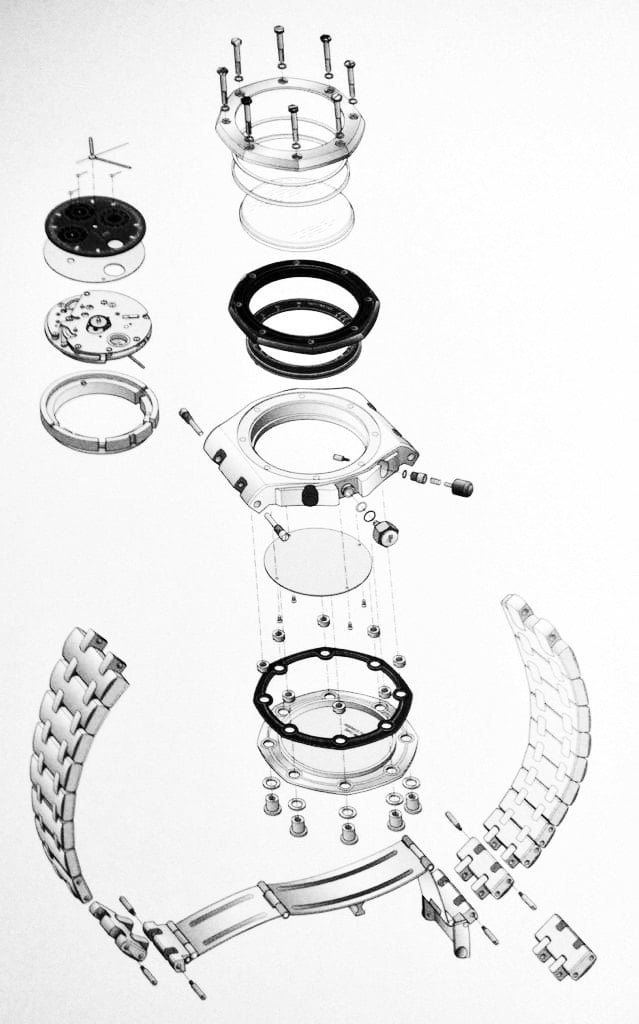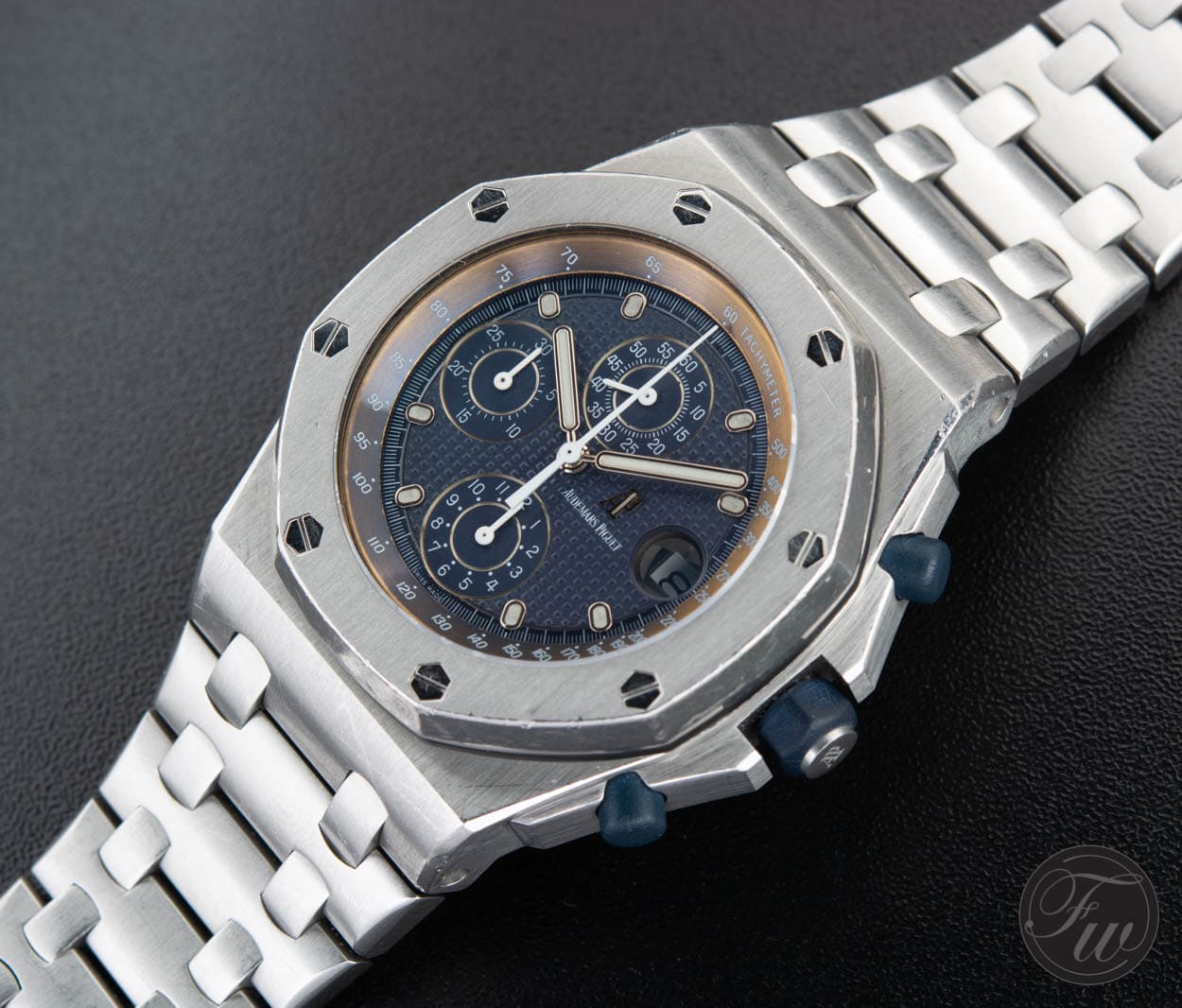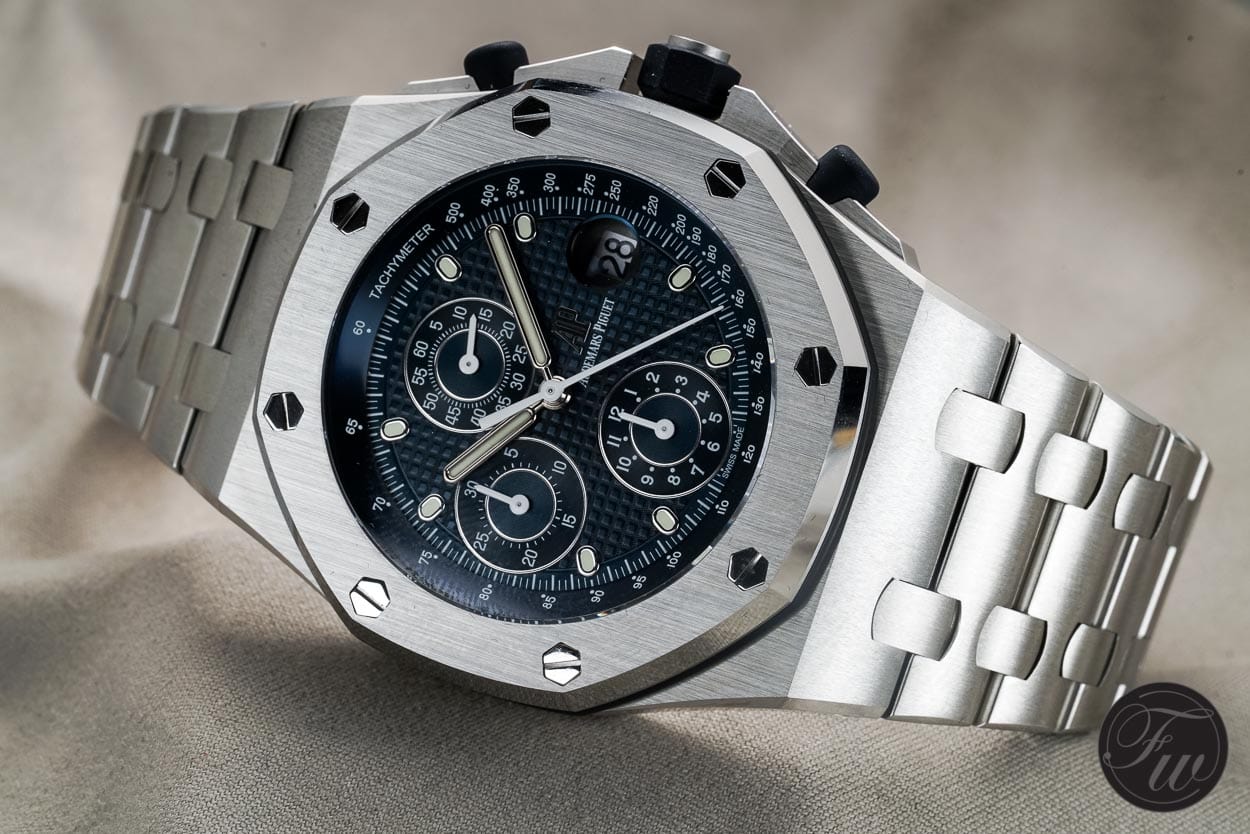25 Years Of Audemars Piguet Royal Oak Offshore
This year marks the 25th anniversary of the Royal Oak Offshore. A watch that was groundbreaking when first shown during the Basel watch fair in 1993, but it took a while to get there.
We sit down with an Audemars Piguet Royal Oak Offshore collector in The Netherlands at a not so central location. Besides being a collector of Offshores watches, he is the founder of a Dutch gin brand by the name of ‘Skully’. So when the bottle of Skully gin appears on the table, the travelling has already become very worthwhile. This Dutch gin is new to Bert (who takes care of the images) and me, but we much appreciate the great flavour. It gets even better when the box with Royal Oak Offshore watches appear on the table as well. This is going to be one amazing afternoon. We will focus on the original Offshore, also nicknamed “The Beast” because of its – especially at that time – impressive proportions. Since 1993, Audemars Piguet has introduced many variations on the Offshore theme, but we’ll stick to the reference 25721ST and its direct descendants.
25 Years of Royal Oak Offshore
1989 – 1993 Urquhart and Gueit
But let’s start at the beginning. The Royal Oak Offshore writes history in 1993, but the story already starts 4 years earlier.
Designing a watch from scratch is not easy. Designing a watch based on an existing successful design is simply problematic. You can almost only do wrong. However, at that time Audemars Piguet’s young designer by the name of Emmanuel Gueit was appointed with the task to do so. Already in 1989, Audemars Piguet co-CEO Stephen Urquhart (who later on joined Omega as CEO) asked Gueit to design a new version of the Royal Oak that would attract a younger audience. According to Gueit it was time for a very masculine watch, as he noticed that women started to wear men’s watches. He wanted a watch that would be regarded as a typical men’s watch: huge proportions. Such extreme proportions that women would refrain from buying or wearing one. Although Urquhart gave the young designer the assignment to come up with something for a younger audience, he wasn’t quite ready for what he was presented with. A thick Royal Oak with impressive proportions and visible gaskets. Although Urquhart liked it, he kept postponing the introduction of this new Royal Oak for a number of years. Thin quartz models were still in demand and this new extreme Royal Oak version could ruin it all. The 20th anniversary of the Royal Oak in 1992 was a moment they intended to grab with the new design, but again another postponing makes it finally 1993 when the Royal Oak Offshore watch comes out. The name Offshore doesn’t appear on the watch at first, as Audemars Piguet is not entirely comfortable with it yet. The first 100 Audemars Piguet Royal Oak Offshore models only bear the name “Royal Oak” in the case back. Starting number 101, they have “Royal Oak Offshore” engraved.
Meet The 1993 Royal Oak Offshore 25721
The watch industry thought the Royal Oak Offshore was a mistake. Just like the Royal Oak was received in 1972, a lot of people thought it was nuts. Even Gérald Genta was not silent about it, he felt that Audemars Piguet created a walrus based on his precious Royal Oak design. A bit awkward really, as he probably received similar comments on his Royal Oak and Nautilus design by conservative collectors in the 1970s. Italy was – as always – in the lead when it came to actual sales of the Royal Oak Offshore, it took the rest of the world a bit longer to follow their example. Only a few years later already, the Royal Oak Offshore made up for a large portion of the sales.
The first reference 25721ST, also nicknamed “The Beast”, was far ahead of its time. A huge and thick case, measuring approximately 16mm in height, the use of rubber for the crown and pushers as well as a visible gasket between case and bezel. All ingredients that we would not even take for granted today. Interestingly, the first Royal Oak Offshore consisted of a faraday construction to prevent the movement from getting magnetized. A soft-iron plate was mounted underneath the dial and soft-iron inner case covering the movement prevented the caliber 2126/2840 movement from being vulnerable to magnetic fields. This movement was based on the often-used Jaeger-LeCoultre 888 caliber added with a chronograph module by Dubois-Depraz. After the first 200 watches, Audemars Piguet started used the caliber 2226/2840 for the Royal Oak Offshore, which was based on the Jaeger-LeCoultre 889/1 with a Dubois-Depraz chronograph module. Combined with the heavy stainless steel bracelet, the watch weighs approximately 223 grams. Not for the faint-hearted. Later gold and platinum models weigh even much more.
Besides a very visible gasket below the octogonal bezel, there are also the rubber (like) pushers and crown. This material is actually referred to as Therban, a high-performance elastomer that is – for example – resistant to very hot water and steam. It can handle extreme temperatures, from –45 degrees Celsius to +165 degrees Celsius, and peaks up to 180 degrees Celsius. This material was developed by Bayer in 1975 and marketed as Therban in 1986. The Therban pushers and crown have the same blue tone as the dial of the watch.
Advertisement
D/E/F-Series
The production period of a Royal Oak Offshore is often referred to as an [X]-series, where [X] stands for a letter that corresponds to certain production years. The Royal Oak Offshore reference 25721 starts as D-series. The production of the D-series Audemars Piguet watches start in 1992 already, but of course, the Royal Oak Offshore is delivered to the market in 1993. The first number of “The Beast” is D23744 and the last watch is the D97184, but these ranges are also used for other Audemars Piguet watches. The last D-series was produced in 1998. In that time period, Audemars Piguet produced 1300 reference 25721ST watches in the D-series. All these watches come in smaller batches (200-100-200-300-200-100-200), adding up to exactly 1300 pieces.
The E-series ran from 1998 till 2004, and the production of the Royal Oak Offshore 25721ST increased from 1300 to 2300 pieces (in smaller batches of 100-200-100-200-600-200-200-200-500). The F-series were introduced in 2005 but there seems to be no logic in those (at least not to us).
Interesting to note that between those first D-series and E-series, there are some small differences that perhaps don’t get noticed right away. Besides the lacking ‘Offshore’ engraving on the case back of the first 100, the different movement in the first 200 and the little change in the tapisserie pattern on the dial, you will also find that the bracelet has been updated over the years. The clasp on the first models was rather simple executed compared to the later ones, but also the links of the bracelet show a difference. On the D-series the links have 4 screws (2 on both sides), on the E-series and later models, that has been reduced to two screws (1 on each side).
A very early Royal Oak Offshore 25721ST with number 039 was auctioned last November by Phillips for a whopping CHF102,500 (Swiss Francs). Not only does it mean it doesn’t have ‘Offshore’ engraved in the case back, but more importantly, it belonged to the original designer of “The Beast”, Emmanuel Gueit. Different from the other early models is the clasp, as it is fitted with the one that Gueit originally had in mind for this watch.
20th Anniversary
Earlier this year during the SIHH in Geneva, we were presented the new Royal Oak Offshore for its 25th anniversary. But let’s not skip the 20th-anniversary edition of the Royal Oak Offshore that Audemars Piguet released in 2013. Limited to just 20 pieces, this reference 26218ST was very close to the original 1993 model. The movement inside was the caliber 3126 / 3840, of which the chronograph mechanism was an add-on module by Dubois-Depraz. The base caliber of this movement has been in-house developed by Audemars Piguet instead of the previous JLC-based ones. This movement consists of 365 parts and has a beautifully decorated 22-carat gold rotor. Just like the famous AP caliber 2121 (that can be found in the 15202ST), it has a Gyromax-like balance wheel. This refers to the variable inertia blocks on the balance wheel for its adjustment.
On this watch we also find a case back with a sapphire crystal, so the movement can be admired by the owner. The bracelet of this model also changed again, as you can see on the images the clasp looks a bit more up-to-date.
As you can see in the images below, the boxes also changed during the years. From the very specific octagonal shaped boxes for the first D and E series to the regular wooden box, they use for all other Royal Oak models. The 2013 anniversary box carried a special medallion on top to indicate it concerns the Royal Oak Offshore 20th anniversary edition.
The Current Beast – 26237ST
On the 25th anniversary of the Royal Oak Offshore, Audemars Piguet re-introduced “The Beast” and is known as their reference 26237ST. The interesting thing is, that this 42mm watch doesn’t feel as 25 years old. Without any historical knowledge, it could be perfectly a watch of today from the Audemars Piguet collection. The 42mm size is not as wild and extreme as it was 25 years ago, but it is certainly also not outdated. Inside, we’ll find the same movement as the 20th-anniversary edition, the AP caliber 3126 / 3840. Just like the original 25721ST models though, this new reference also has a solid stainless steel case back. It is engraved with “Royal Oak Offshore” and the serial number. This might feel like a disappointment for those who love to see the movement with 22-carat gold rotor, but purists probably prefer the closed back from an originality point of view. “The Beast” is back, and as a normal production run model, not as a limited edition. This watch resembles the original 25721ST but of course, an eagle-eye already noticed that the printing on the dial is a bit bolder.
Royal Oak Offshore Icon
Just like the Royal Oak “Jumbo” that developed from the first 5402ST models to today’s 15202ST over a time span of +40 years, the Royal Oak Offshore in the meantime also proved itself to be an icon. And a very young one, as most watches that are considered a classic or have an iconic status has been on the market much longer. Where not everyone seemed to be convinced at first, including Gérald Genta, the Royal Oak Offshore proved to be a winner for many watch enthusiasts and – of course – for Audemars Piguet. At some point, and perhaps it still does, the Offshore collection made up for most of the revenue for this Le Brassus based manufacturer. “The Beast” is still probably the rawest versions of the Royal Oak Offshore, as Audemars Piguet created many differentiations over the past 25 years, including a 37mm lady’s version (not something Emmanuel Guiet had in mind in 1993). The collection has also expanded with 42mm non-chronograph divers, 44mm chronographs and 45mm Tourbillon Chronographs but there’s only one original, which is “The Beast”. And now it is back.
We would like to thank Royal Oak Offshore collector Koen Smulders for enabling us to take images of his watches and sharing his impressive knowledge on these models.
More information on Audemars Piguet’s Royal Oak Offshore collection can be found here.



























































